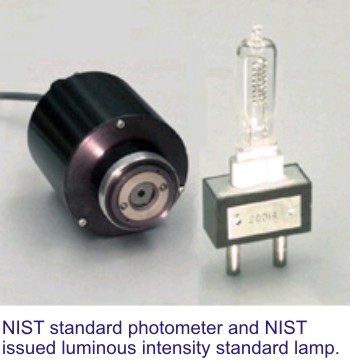| * |
|
Photometry
Summary:The purpose of photometry is to measure light in a way that takes the sensitivity of human visual system into account. While radiometry measures light in all spectral regions, including ultraviolet and infrared, photometry only measures in the visible spectral region from 360 nm to 830 nm, where human eyes are sensitive. Thus, photometry is essential for evaluation of light sources and objects used for lighting, signaling, displays, and other applications where light is intended to be seen by humans. NIST’s program in photometery involves maintaining the SI base unit of luminous intensity, the candela, as well as other photometric quantities; establishing national calibration standards and services for retroreflectivity; and educating the photometric community about the fundamentals and practical aspects of photometry and photometric measurements. Description:Realization of photometric quantitiesThe candela, SI base unit of luminous intensity, is realized with a detector-based method, dependent on the absolute responsivity of detectors. It is maintained on a group of eight standard photometers, which are calibrated annually and traceable to Division's reference cryogenic radiometer (POWR). The lumen, the unit of total luminous flux, is realized from the candela using the Absolute Integrating Sphere Method implemented in the NIST 2.5-m integrating sphere. For more details about the realization of these quantities, see Realization of the candela, Realization of the lumen, and Realization of related photometric units. Center for High Accuracy Retroreflection Measurements (CHARM)As retroreflective traffic control devices are widely used for nighttime visibility and safety, Congress has directed the United States Department of Transportation to establish "a standard for a minimum level of retroreflectivity that must be maintained for pavement markings and signs which apply to all roads open to public travel." Developing a national standard for minimum levels of retroreflectivity will require accurate methods to measure retroreflectivity. In response to this need, NIST established the Center for High Accuracy Retroreflective Measurements (CHARM). Its objective is to develop a dedicated reference instrument for measuring retroreflective materials and a calibration program that provides traceability to the relevant national scales maintained by NIST. For more information about the reference instrument, see Center for High Accuracy Retroreflection Measurements. Calibration ServicesThe photometry program includes calibration services which provide access to the photometric scales realized and maintained at NIST. These services include lamp standards of luminous intensity, luminous flux, and color temperature; calibration services for retroreflective materials; and reference photometers and materials. A detailed list of services is available through NIST Calibration Services at Photometric measurements. Please contact Cameron Miller to discuss the details of the services and obtain a quote for the requested calibration. Photometry short courseThis course covers fundamentals in photometry, radiometry, and colorimetry as well as practical aspects of measurements of luminous flux, luminous intensity, illuminance, luminance, color temperature, and chromaticity of light sources. It is offered every two years. The most recent course took place in August 2009. The next course is expected to be offered in late-Summer 2011. For more information, see NIST Photometry short course. |
 Lead Organizational Unit:pmlFacilities/Tools Used:NIST Photometry Bench Staff:Related Programs and Projects:Contact
Photometry: 100 Bureau Drive, M/S 8442
|
